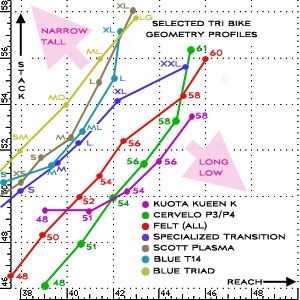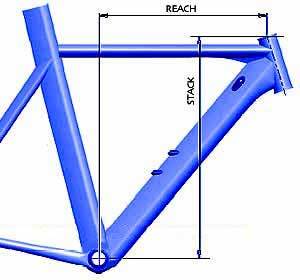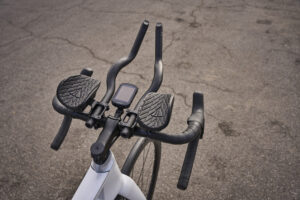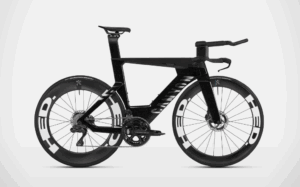Graphing geometric themes

First, let's talk about what this graph means. An astute Slowtwitcher commented on previous iterations of graphs like this, that I ought to change the axis to read like this graph now does. If you can imagine looking at a bike in profile, from the drive side, the points on this graph are placed to more or less mimic what's going on geometrically.
When you look at a Scott Plasma 1, or a Blue Triad, in their largest sizes, you're looking at bikes that have head tubes that are very high above the bottom bracket. But if you look at a Kuota Kueen K, in its largest size, it's not very tall at all relative to the Scott and the Blue. But the Kueen K's head tube top is farther in front of the bottom bracket. The bike is longer (in terms of how it'll fit), and it's lower.
We've plotted size runs of seven sample bikes to give you an idea what we're talking about. The numbers are in centimeters (but the graph is not to scale). They refer to the distance the head tube top is in front of, and above, the bottom bracket. The image below demonstrates this graphically.
So as you'll note, the Cervelo P3 and P4, in size 54cm, feature head tubes that sit 50cm above the bottom bracket, and 42cm in front of the bottom bracket. Meanwhile, the Felt models in 60cm have head tube tops that sit 56cm above the bottom bracket, and about 46cm in front of the bottom bracket.
The metrics we favor using for this exercise are "reach" and "stack", which are X and Y measures respectively between the bottom bracket and the head tube top. The numbers listed on this chart refer to reach and stack.
The Blue, the Scott, and the Specialized are what we call "narrow/tall" bikes. This, because the head tube top does not sit very far in front of the bottom bracket, but it does sit quite high above the bottom bracket, relative to its length.
I'd like you to notice a few things. First, you can see that the Kueen K, the P3 and the Felt geometries are for the most part "long and low." But the Felt is less long/low than the other two. Conversely, the Transition, T14 and Plasmas are "narrow and tall."
But they are not all uniformly narrow/tall, or long/low. Further, some are not uniformly of a particular style throughout their size runs.

For example, the Kueen K is in the main long and low, but, as the sizes get smaller this model trends away from long and low. Why is this? Mostly, because the bike doesn't offer 650c models in the small sizes. This causes the bike to resist remaining a "low" bike in the smaller sizes because the 700c front wheel can only allow the bike to be made so low, and no lower. In fact, the Kueen K in size XS is not any lower than the size S, because each cousin shares the same 95mm head tube length.
The Specialized Transition is a uniformly narrower/taller bike than Cervelo's P3. Until the tallest size. The Transition's head tube grows from 135mm in size XL to 150mm in size XXL, while its front/center grows by more than 30mm. The P3 also grows in head tube size by 15mm from it's 58cm to its 60cm, but, the front/center grows by only half that much.
In other words, the Transition grows "length" at a much faster rate than does the P3 between these two sizes, while it grows in height at the same rate as the P3. The Transition becomes a moderately long/low bike, sitting on the P3's geometry curve, in its tallest size. But in the other sizes, it's geometrically a different animal (albeit not by a huge amount).
The Blue T14 starts out, in its smallest size, as about the narrowest/tallest bike in the tri industry (for that size). And it ends up that way in its largest size. But in the middle sizes its geometric theme changes.
But the Blue Triad is not built that way. Yes, geometrically it is a narrow/tall bike, just like the T14, but the "grading" of the frame bespeaks a more uniform attachment to a particular geometric theme.
Note that the lowest bikes—those with the least stack—on this chart are the pair of 48cm bikes made by Cervelo and Felt. The reason is simple: These bikes are made with 650c wheels. If you're shorter than 5'6" and you have difficulty getting the front end of your bike low enough, you can see why this is. A stack below 50cm is almost unheard of on a bike built with 700c wheels, but Kestrel, Cervelo, Felt and QR offer bikes with a stack 4cm, 5cm, even 6cm lower than anything achievable on a bike built with a 700c front wheel.
Note that T-shirt sizing is imprecise, and that bike companies feel no compunction to normalize with each other. Or, in some cases, to normalize even among their own models. Scott's M and the Specialized in L are pretty similar bikes, geometrically. The Specialized in XL is no longer than the Blue T14 in L, but the T14 in L is taller. Meanwhile the Blue Triad in LG is almost identical to the Scott Plasma in XL.
It's no different in the numbered sizes. The Kuota Kueen K is a taller bike in 51cm than the P3, but close to the same length. But in 56cm, it's reversed. The Kueen K is longer than the P3 in the same size, but close to the same height. As noted, this is because the Kueen K is not uniformly one style of bike throughout its size run, while the P3 largely is.
None of this is good or bad, it just is. The lack of a bike's tendency to stay true to a geometric theme throughout its size run does not make it a bad bike. But it does make it a different bike, depending on its size. As long as you note the difference, you'll be okay.
This has been mentioned numerous times, but, like the Krebs Cycle, you can't learn it enough, right? So here goes:
Who needs a narrow/tall bike? In general, two types of folks: 1) Those who'll ride with a shallower seat angle, which usually (but not always) means the front of their bikes will be a little taller because of their choice of shallower seat angle; and 2) Those who are long-legged, and short in the torso.
There are other factors. For example, if you intend to ride with a very low profile aerobar (with armrests the tops of which sit perhaps 2cm or 3cm above the centerline of the pursuit bar), you'll need a marginally taller frame to take up that space usually taken up by the aerobar. Also, if you choose a stem with an extension that's parallel to the ground, you'll need to make up that elevation difference, either by spacers (bad idea) or frame height (good idea).
Who needs a long/low bike? Typically, those who'll ride a steeper seat angle, and whose steeper angle allows or causes them to ride with a lower front end. Also, short-leg, long-torso riders need a lower front end (to correspond to their shorter legs) and more "reach" (more horizontal distance between the crank and the head tube top). Also, riders who choose an aerobar with armrests that sit high above the pursuit bar (e.g., Profile T2, Syntace), may need a lower frame to make room for this tallish aerobar geometry.







Start the discussion at forum.slowtwitch.com